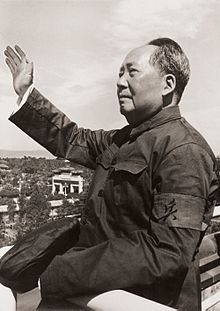The Daxing Massacre (Chinese: 大兴屠杀; pinyin: Dàxīng túshā), also known as the Daxing Incident (大兴事件), was part of the Red August massacre in Beijing during the early Cultural Revolution.[1][2][3][4][5][6] It took place in Daxing District of Beijing from August 27 to 31, primarily targeting members of the Five Black Categories.[3][6][7][8] In total, 325 people were killed in the massacre by September 1, 1966; the oldest killed was 80 years old, while the youngest was only 38 days old; 22 families were wiped out.[1][3][6][9]
| Daxing Massacre | |
|---|---|
| Part of Cultural Revolution in China | |
 On August 18, 1966, Mao Zedong met with student in Tiananmen prior to the mass killings in Beijing | |
| Native name | 大兴屠杀 |
| Location | Daxing District, Beijing, China |
| Date | 27 August 1966 August – September 1966 |
| Target | "Five Black Categories" (Landlords, wealthy peasants, bad influences/elements, right wingers) |
Attack type | Politicide, politically motivated violence |
| Deaths | 325 (Official statistics) |
| Victims | landlords, property owners, "class enemies", suspected civilians |
| Perpetrators | Chinese Communist Party, student Red Guards incited by Mao Zedong |
| Motive | Destruction of the "Four Olds (Old cultures, old customs, old habits and ideas) and Five Black Categories (Landlords, wealthy peasants, bad influences/elements and "right wingers") |
The Daxing Massacre occurred after Mao Zedong publicly supporting Red Guards' movement in Beijing and Xie Fuzhi, the Minister of Ministry of Public Security, ordering to protect the Red Guards and not arrest them; on August 26, 1966, the day before the massacre began, Xie stated that it was not incorrect for the Red Guards to beat "bad people", and it was fine if the "bad people" were killed.[1][3][10][11][12] Methods of torture and slaughter during the Daxing massacre included beating, whipping, strangling, trampling, and beheading; in particular, the method used to kill most infants and children were knocking them against the ground or slicing them in halves.[6][13][14][15]
See also
editReferences
edit- ^ a b c Jian, Guo; Song, Yongyi; Zhou, Yuan (2015-07-23). Historical Dictionary of the Chinese Cultural Revolution. Rowman & Littlefield. ISBN 978-1-4422-5172-4.
- ^ "A Massacre in Daxing County During the Cultural Revolution". Chinese Law & Government. 14 (3): 70–71. 2014-12-07. doi:10.2753/CLG0009-4609140370.
- ^ a b c d Song, Yongyi (2011-08-25). "Chronology of Mass Killings during the Chinese Cultural Revolution (1966-1976)". Sciences Po. Archived from the original on 2018-04-13. Retrieved 2020-02-15.
- ^ Southerl, Daniel (1994-07-18). "A NIGHTMARE LEAVES SCARS, QUESTIONS". Washington Post. ISSN 0190-8286. Retrieved 2019-12-23.
- ^ "Ignoring the past". The Economist. ISSN 0013-0613. Retrieved 2020-02-15.
- ^ a b c d Yu, Luowen. "文革时期北京大兴县大屠杀调查". Chinese University of Hong Kong. Archived from the original on 2016-08-04. Retrieved 2020-02-15.
- ^ Sun, Yancheng. "血统论和大兴"八三一"事件". Yanhuang Chunqiu (in Chinese). Archived from the original on 2020-09-22. Retrieved 2019-12-08.
- ^ Qi, Zhi (2019-11-26). 中华学人论文集——文化大革命50年(1-4): 文献与综述(一) (in Chinese). Remembering Publishing, LLC. ISBN 978-1-951135-05-8.
- ^ Hu, Ping (2010-11-02). "谁是大兴县血案的罪魁祸首?(胡平)". Radio Free Asia (in Chinese (China)). Archived from the original on 2019-12-08. Retrieved 2019-12-08.
- ^ "文革公安部长谢富治谈红卫兵打死人:我们管不着". Phoenix New Media (in Chinese). Archived from the original on 2019-12-10. Retrieved 2019-12-10.
- ^ "卞仲耘丈夫:宋彬彬没参与打人 但她是一伙儿的". Phoenix New Media (in Chinese). Archived from the original on 2019-12-10. Retrieved 2019-12-10.
- ^ "对红卫兵组织失去信任 毛泽东决定下放知青始末". Phoenix New Media (in Chinese). Renming Wang. 2009-12-14. Archived from the original on 2015-05-27. Retrieved 2019-12-10.
- ^ Wang, Youqin. "文革受难者 ——关于迫害、监禁和杀戮的寻访实录" (PDF) (in Chinese). University of Chicago. Archived (PDF) from the original on 2016-10-12.
- ^ "北京大兴文革屠杀:婴儿被劈成两半". Boxun (in Chinese). 2013-08-01. Archived from the original on 2013-08-04. Retrieved 2019-12-10.
- ^ "集体遗忘文革,无疑是一种更深远的民族公耻". Ipkmedia (光传媒) (in Chinese). 2019-10-18. Archived from the original on 2020-05-22. Retrieved 2019-12-10.